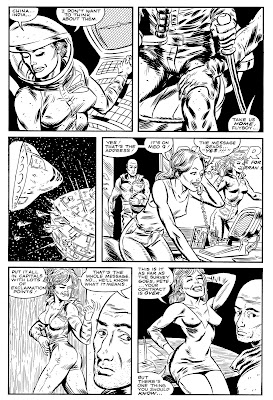 |
| Colorized panel from page 4. |
Higher-res scans courtesy of George Hagenauer, who has these pages for sale!
[Interspersed is my original plot, from the original text document.]
"Four Letter Word"
J. Jonah Jameson, at his desk in his office at the Bugle, trying to figure out the paper's crossword puzzle.
17 Across: To tug, suddenly
Jonah goes through various expressions of frustration, exasperation, befuddlement, etc.
Looks through crossword dictionary, throughs it into wastepaper basket in anger.
Robbie Robertson sticks his head into the office, concerned at loud noise.
Jonah asks Robbie. Robbie shrugs.
Jonah goes to door of office, holding folded paper and pencil, quizzes his perky receptionist. She doesn't know the answer.
Jonah asks the even quirkier punkette intern making photocopies, a flat-chested, tattooed, gum-chewing brat. She doesn't have a clue either. She give Jonah the finger once his back is turned, as he storms back into his office.
Close up of puzzle - answer in tomorrow's Bugle. Jonah gets an idea - smiles!
Calls down to puzzle/features department. The stern librarian-looking editor scolds him, wagging her finger. She can't divulge the answers!
Jonah pulling his hair out. Paper nearly in shreads. About to give up. Jonah, resignedly, looks forlornly at the paper. Doesn't see behind him, out window, as Spidey swings up.
Spidey, taking a perch upside down outside the window, below the sill, looks in curiously at Jonah.
Jonah, gesturing with his hands, eyes closed, says something out loud.
Spidey, hands to his mouth, yells something at Jonah.
Eureka! Jonah has the answer at last! Pencils in the word 'jerk'.
Jonah beams. Then his face falls into a not-amused frown.
As Spidey swings away chuckling to himself, Jonah shouts and waves fist at him angrily leaning out of the open window.
Anyway, the thumbnails and final versions tell a little story of J. Jonah Jameson struggling to complete his own paper's crossword puzzle, calling the puzzle's editor for some extra clues (she scolds him for trying to cheat), and finally Spider-Man dropping by, uttering the only dialogue in the sequence, and inadvertently solving the puzzle. I thought it was kind of clever.
As I've mentioned elsewhere, it is a bit astonishing to me as I look back on these samples to see the level of mastery and craft one could attain and still get no response from the major publishers. This, coupled with what I considered the dreadful level of craft manifest in the books since the 1970s ... but then, I'm sorta biased. Some would say it is simply a changing of style; as I've written elsewhere, I think the cognitive skill of drawing has all but vanished from our civilization.
Keep those submissions coming! Failed Pitch One | Two | Three | Inferior Five!
________
Read my YA prose experiment, the Ms. Megaton Man Maxi-Series - new chapter every Friday!








































